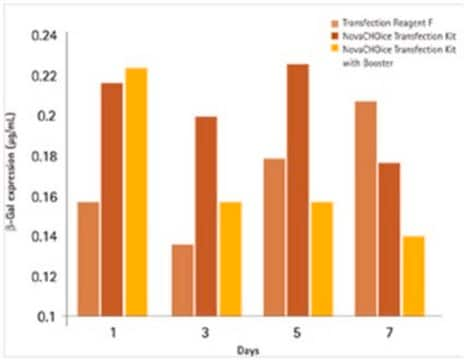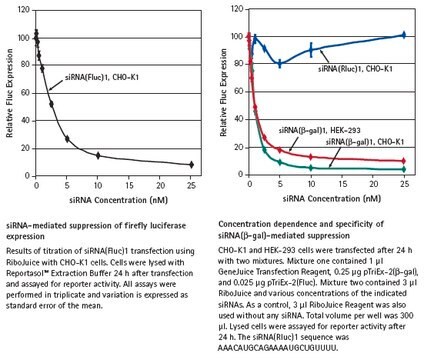L3287
Escort™ IV Transfection Reagent
Lipid reagent for transient and stable transfection of mammalian and insect cells.
Sinônimo(s):
Gene delivery
About This Item
Produtos recomendados
grau
for molecular biology
Nível de qualidade
forma
liquid (aqueous solution)
uso
1 mL sufficient for 160-500 transfections
concentração
1 mg/mL
técnica(s)
transfection: suitable
temperatura de armazenamento
2-8°C
Categorias relacionadas
Descrição geral
Aplicação
Características e benefícios
- Suitable for stable and transient transfection
- Optimized for a wide variety of cell lines
- Low toxicity
- Compatible with both serum and serum-free transfection protocols
- Ideal for Sf9, Sf21 and S2 insect cells
Componentes
1 mg/mL total lipid in water
Note the identity of the lipids used in Escort™ IV is confidential.
Atenção
Princípio
Informações legais
produto relacionado
Código de classe de armazenamento
10 - Combustible liquids
Classe de risco de água (WGK)
WGK 3
Ponto de fulgor (°F)
Not applicable
Ponto de fulgor (°C)
Not applicable
Equipamento de proteção individual
Eyeshields, Gloves
Certificados de análise (COA)
Busque Certificados de análise (COA) digitando o Número do Lote do produto. Os números de lote e remessa podem ser encontrados no rótulo de um produto após a palavra “Lot” ou “Batch”.
Já possui este produto?
Encontre a documentação dos produtos que você adquiriu recentemente na biblioteca de documentos.
Os clientes também visualizaram
Artigos
Transfection introduces genetic material into cells, aiding research in gene expression and cell biology.
This brief webinar provides an overview of what transfection is and the methods that are used to introduce DNA or RNA into eukaryotic cells.
Protocolos
The product bulletin providin detailed use protocol for easy DNA transfection.
Product manual provides detailed protocol for easy DNA transfection.
Universal Transfection Reagent enables efficient nucleic acid delivery into various cells, compatible with different cell culture conditions.
Calcium phosphate transfection is a common method for the introduction of DNA into eukaryotic cells. This protocol can be optimized for use with a wide variety of cell types.
Conteúdo relacionado
Browse our convenient transfection reagent selection guide to match the best reagent for your specific cell line and application needs.
Nossa equipe de cientistas tem experiência em todas as áreas de pesquisa, incluindo Life Sciences, ciência de materiais, síntese química, cromatografia, química analítica e muitas outras.
Entre em contato com a assistência técnica









